Strategic Analysis of Starbucks' Market Entry and Operations in India
VerifiedAdded on 2020/10/22
|8
|2257
|181
Report
AI Summary
This report provides a comprehensive analysis of Starbucks' operations in India, examining its market entry strategy, identifying key threats and opportunities, and applying Porter's Five Forces model to assess the competitive landscape. It delves into Starbucks' current supply chain model, comparing it with alternative approaches, and explores the concepts of convergence and divergence in its business practices. The report also addresses the tax issues faced by Starbucks in India, particularly the impact of GST, and evaluates the benefits and challenges associated with its expansion in the Indian market. The analysis includes discussions on supply chain linkages, manpower skill levels, and infrastructure limitations. The report concludes by summarizing the key findings and providing insights into Starbucks' strategic positioning in India.
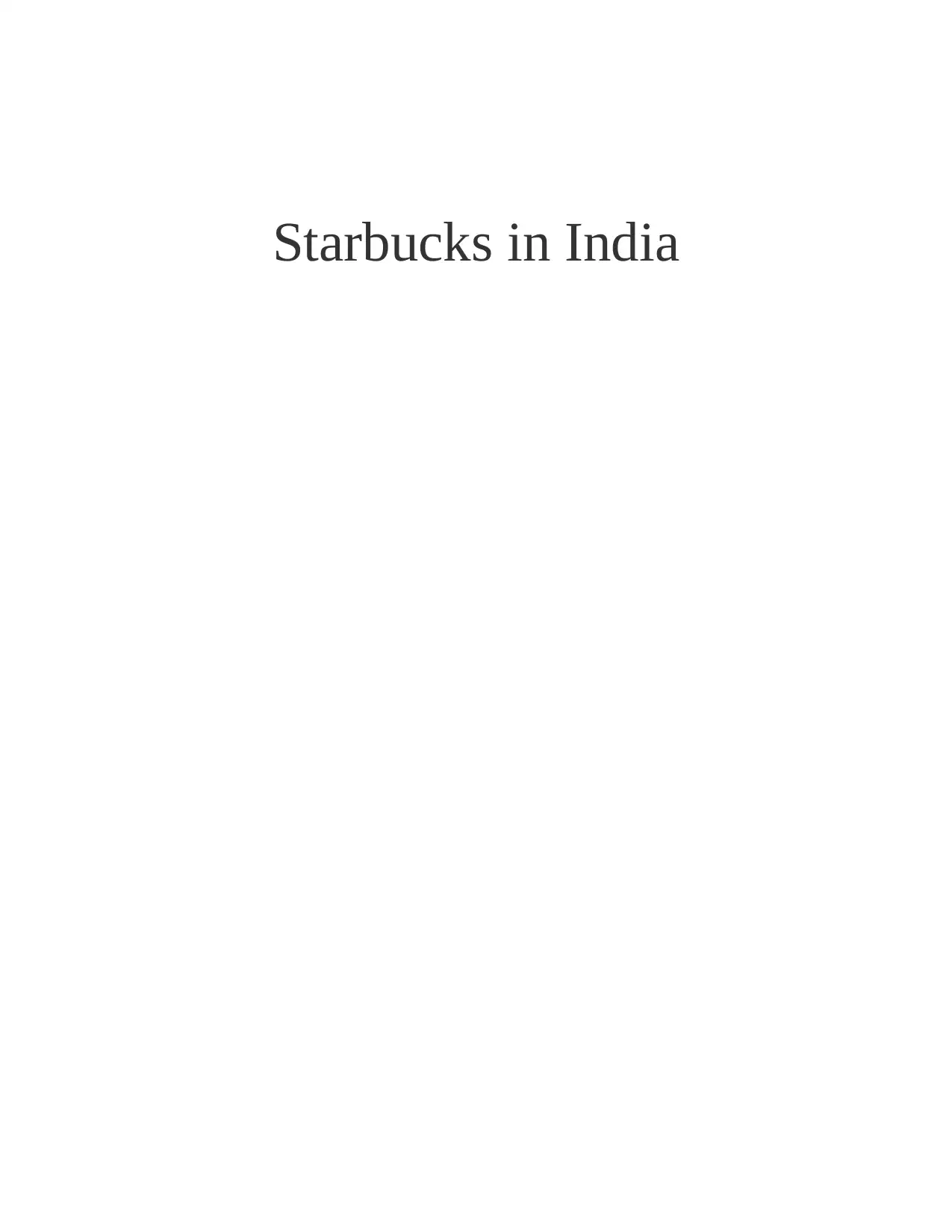
Starbucks in India
Paraphrase This Document
Need a fresh take? Get an instant paraphrase of this document with our AI Paraphraser
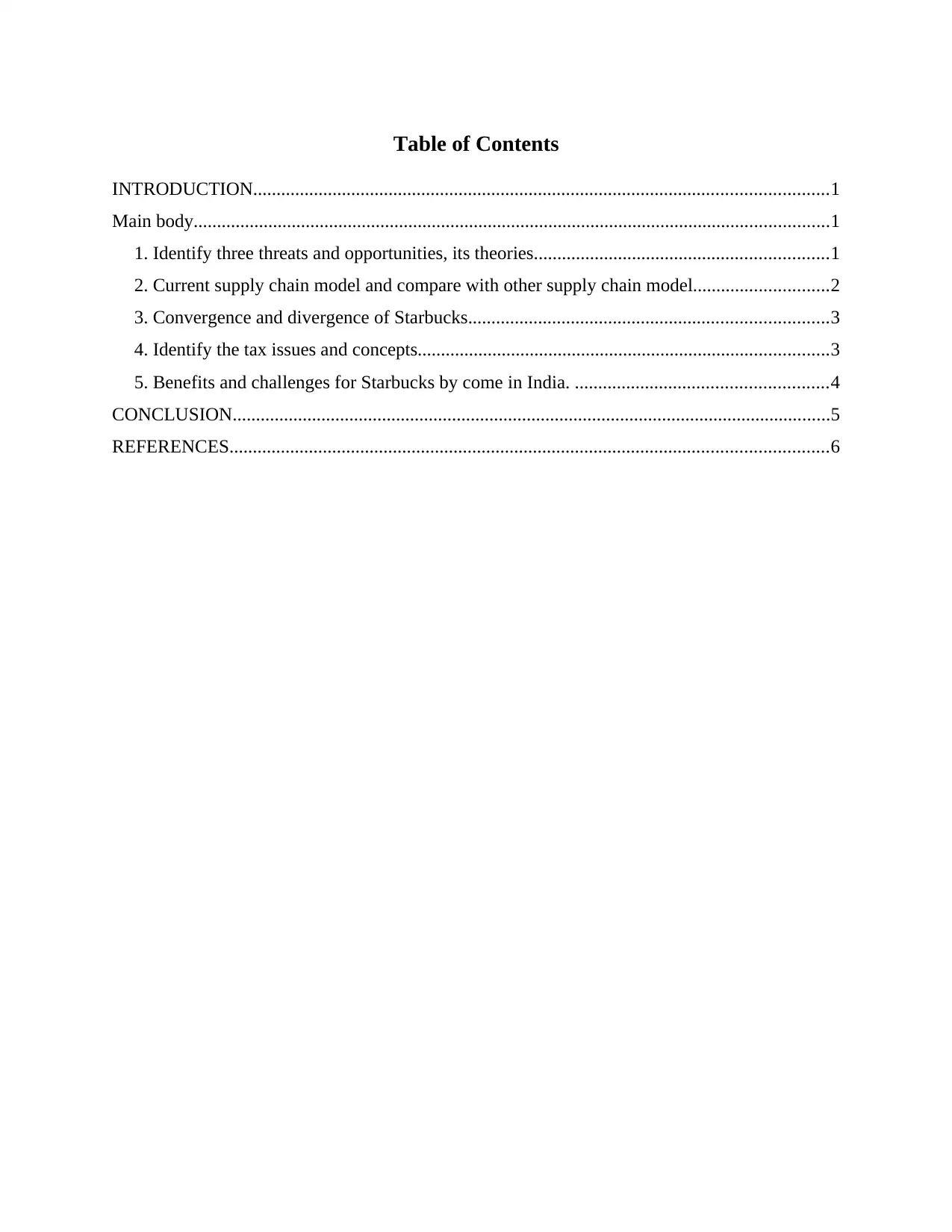
Table of Contents
INTRODUCTION...........................................................................................................................1
Main body........................................................................................................................................1
1. Identify three threats and opportunities, its theories...............................................................1
2. Current supply chain model and compare with other supply chain model.............................2
3. Convergence and divergence of Starbucks.............................................................................3
4. Identify the tax issues and concepts........................................................................................3
5. Benefits and challenges for Starbucks by come in India. ......................................................4
CONCLUSION................................................................................................................................5
REFERENCES................................................................................................................................6
INTRODUCTION...........................................................................................................................1
Main body........................................................................................................................................1
1. Identify three threats and opportunities, its theories...............................................................1
2. Current supply chain model and compare with other supply chain model.............................2
3. Convergence and divergence of Starbucks.............................................................................3
4. Identify the tax issues and concepts........................................................................................3
5. Benefits and challenges for Starbucks by come in India. ......................................................4
CONCLUSION................................................................................................................................5
REFERENCES................................................................................................................................6
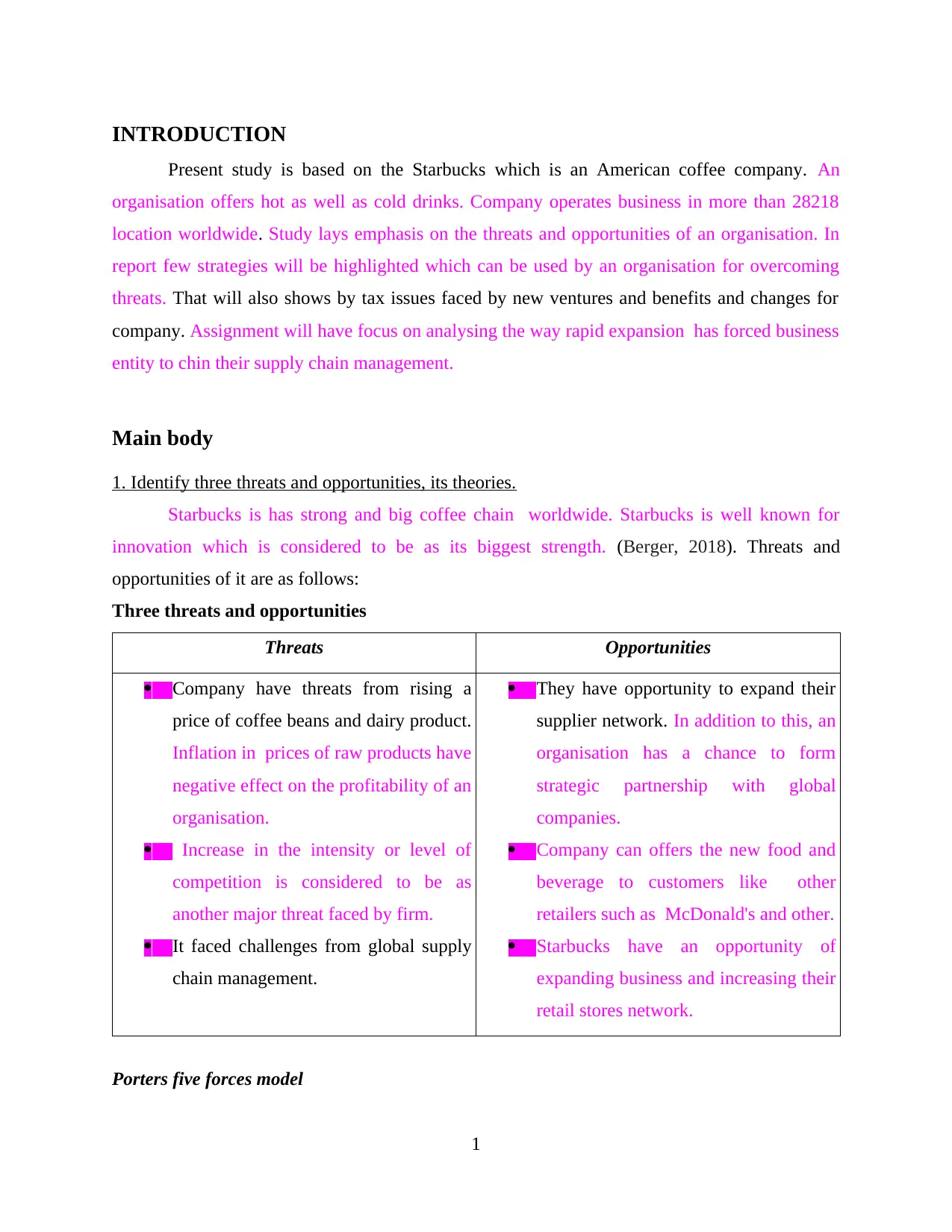
INTRODUCTION
Present study is based on the Starbucks which is an American coffee company. An
organisation offers hot as well as cold drinks. Company operates business in more than 28218
location worldwide. Study lays emphasis on the threats and opportunities of an organisation. In
report few strategies will be highlighted which can be used by an organisation for overcoming
threats. That will also shows by tax issues faced by new ventures and benefits and changes for
company. Assignment will have focus on analysing the way rapid expansion has forced business
entity to chin their supply chain management.
Main body
1. Identify three threats and opportunities, its theories.
Starbucks is has strong and big coffee chain worldwide. Starbucks is well known for
innovation which is considered to be as its biggest strength. (Berger, 2018). Threats and
opportunities of it are as follows:
Three threats and opportunities
Threats Opportunities
Company have threats from rising a
price of coffee beans and dairy product.
Inflation in prices of raw products have
negative effect on the profitability of an
organisation.
Increase in the intensity or level of
competition is considered to be as
another major threat faced by firm.
It faced challenges from global supply
chain management.
They have opportunity to expand their
supplier network. In addition to this, an
organisation has a chance to form
strategic partnership with global
companies.
Company can offers the new food and
beverage to customers like other
retailers such as McDonald's and other.
Starbucks have an opportunity of
expanding business and increasing their
retail stores network.
Porters five forces model
1
Present study is based on the Starbucks which is an American coffee company. An
organisation offers hot as well as cold drinks. Company operates business in more than 28218
location worldwide. Study lays emphasis on the threats and opportunities of an organisation. In
report few strategies will be highlighted which can be used by an organisation for overcoming
threats. That will also shows by tax issues faced by new ventures and benefits and changes for
company. Assignment will have focus on analysing the way rapid expansion has forced business
entity to chin their supply chain management.
Main body
1. Identify three threats and opportunities, its theories.
Starbucks is has strong and big coffee chain worldwide. Starbucks is well known for
innovation which is considered to be as its biggest strength. (Berger, 2018). Threats and
opportunities of it are as follows:
Three threats and opportunities
Threats Opportunities
Company have threats from rising a
price of coffee beans and dairy product.
Inflation in prices of raw products have
negative effect on the profitability of an
organisation.
Increase in the intensity or level of
competition is considered to be as
another major threat faced by firm.
It faced challenges from global supply
chain management.
They have opportunity to expand their
supplier network. In addition to this, an
organisation has a chance to form
strategic partnership with global
companies.
Company can offers the new food and
beverage to customers like other
retailers such as McDonald's and other.
Starbucks have an opportunity of
expanding business and increasing their
retail stores network.
Porters five forces model
1
⊘ This is a preview!⊘
Do you want full access?
Subscribe today to unlock all pages.

Trusted by 1+ million students worldwide
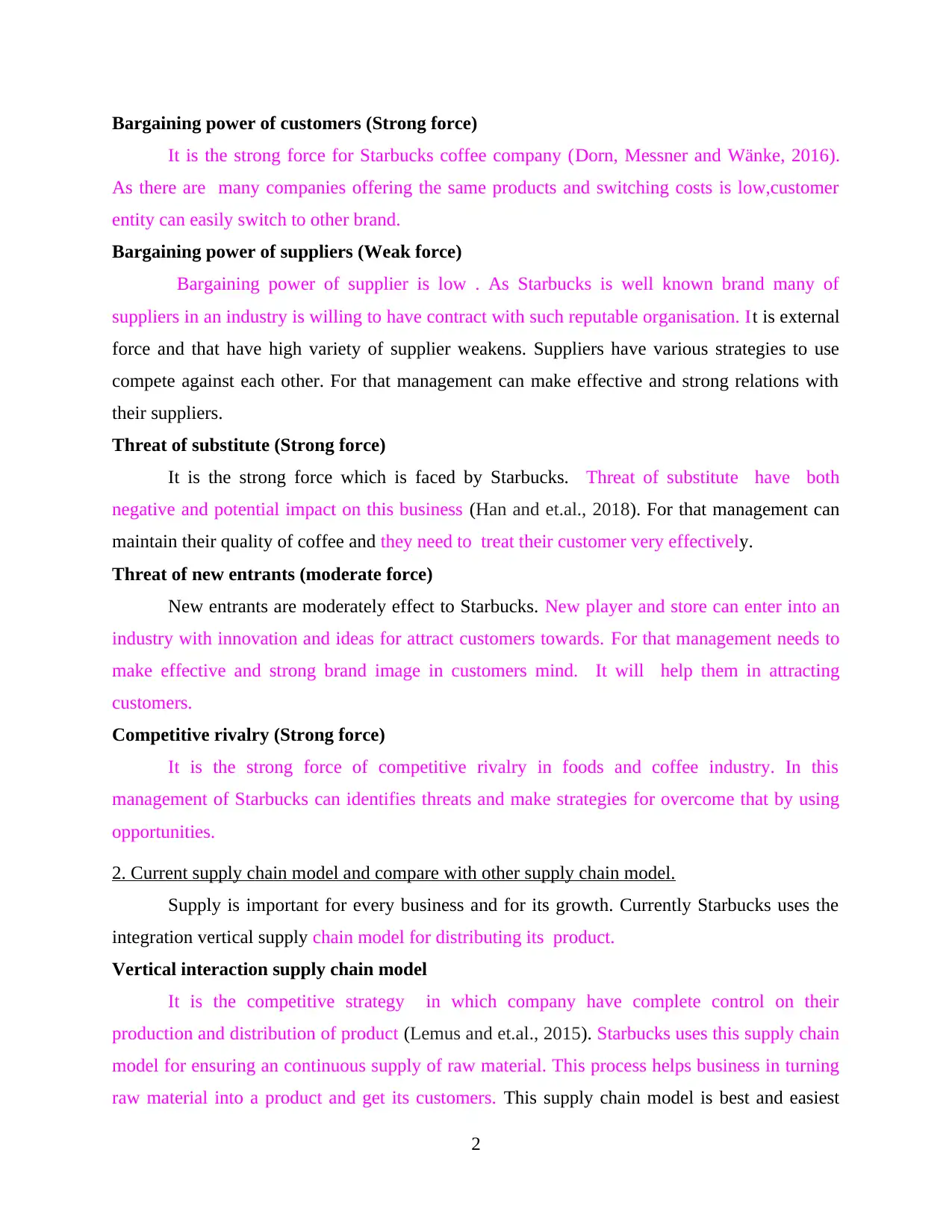
Bargaining power of customers (Strong force)
It is the strong force for Starbucks coffee company (Dorn, Messner and Wänke, 2016).
As there are many companies offering the same products and switching costs is low,customer
entity can easily switch to other brand.
Bargaining power of suppliers (Weak force)
Bargaining power of supplier is low . As Starbucks is well known brand many of
suppliers in an industry is willing to have contract with such reputable organisation. It is external
force and that have high variety of supplier weakens. Suppliers have various strategies to use
compete against each other. For that management can make effective and strong relations with
their suppliers.
Threat of substitute (Strong force)
It is the strong force which is faced by Starbucks. Threat of substitute have both
negative and potential impact on this business (Han and et.al., 2018). For that management can
maintain their quality of coffee and they need to treat their customer very effectively.
Threat of new entrants (moderate force)
New entrants are moderately effect to Starbucks. New player and store can enter into an
industry with innovation and ideas for attract customers towards. For that management needs to
make effective and strong brand image in customers mind. It will help them in attracting
customers.
Competitive rivalry (Strong force)
It is the strong force of competitive rivalry in foods and coffee industry. In this
management of Starbucks can identifies threats and make strategies for overcome that by using
opportunities.
2. Current supply chain model and compare with other supply chain model.
Supply is important for every business and for its growth. Currently Starbucks uses the
integration vertical supply chain model for distributing its product.
Vertical interaction supply chain model
It is the competitive strategy in which company have complete control on their
production and distribution of product (Lemus and et.al., 2015). Starbucks uses this supply chain
model for ensuring an continuous supply of raw material. This process helps business in turning
raw material into a product and get its customers. This supply chain model is best and easiest
2
It is the strong force for Starbucks coffee company (Dorn, Messner and Wänke, 2016).
As there are many companies offering the same products and switching costs is low,customer
entity can easily switch to other brand.
Bargaining power of suppliers (Weak force)
Bargaining power of supplier is low . As Starbucks is well known brand many of
suppliers in an industry is willing to have contract with such reputable organisation. It is external
force and that have high variety of supplier weakens. Suppliers have various strategies to use
compete against each other. For that management can make effective and strong relations with
their suppliers.
Threat of substitute (Strong force)
It is the strong force which is faced by Starbucks. Threat of substitute have both
negative and potential impact on this business (Han and et.al., 2018). For that management can
maintain their quality of coffee and they need to treat their customer very effectively.
Threat of new entrants (moderate force)
New entrants are moderately effect to Starbucks. New player and store can enter into an
industry with innovation and ideas for attract customers towards. For that management needs to
make effective and strong brand image in customers mind. It will help them in attracting
customers.
Competitive rivalry (Strong force)
It is the strong force of competitive rivalry in foods and coffee industry. In this
management of Starbucks can identifies threats and make strategies for overcome that by using
opportunities.
2. Current supply chain model and compare with other supply chain model.
Supply is important for every business and for its growth. Currently Starbucks uses the
integration vertical supply chain model for distributing its product.
Vertical interaction supply chain model
It is the competitive strategy in which company have complete control on their
production and distribution of product (Lemus and et.al., 2015). Starbucks uses this supply chain
model for ensuring an continuous supply of raw material. This process helps business in turning
raw material into a product and get its customers. This supply chain model is best and easiest
2
Paraphrase This Document
Need a fresh take? Get an instant paraphrase of this document with our AI Paraphraser
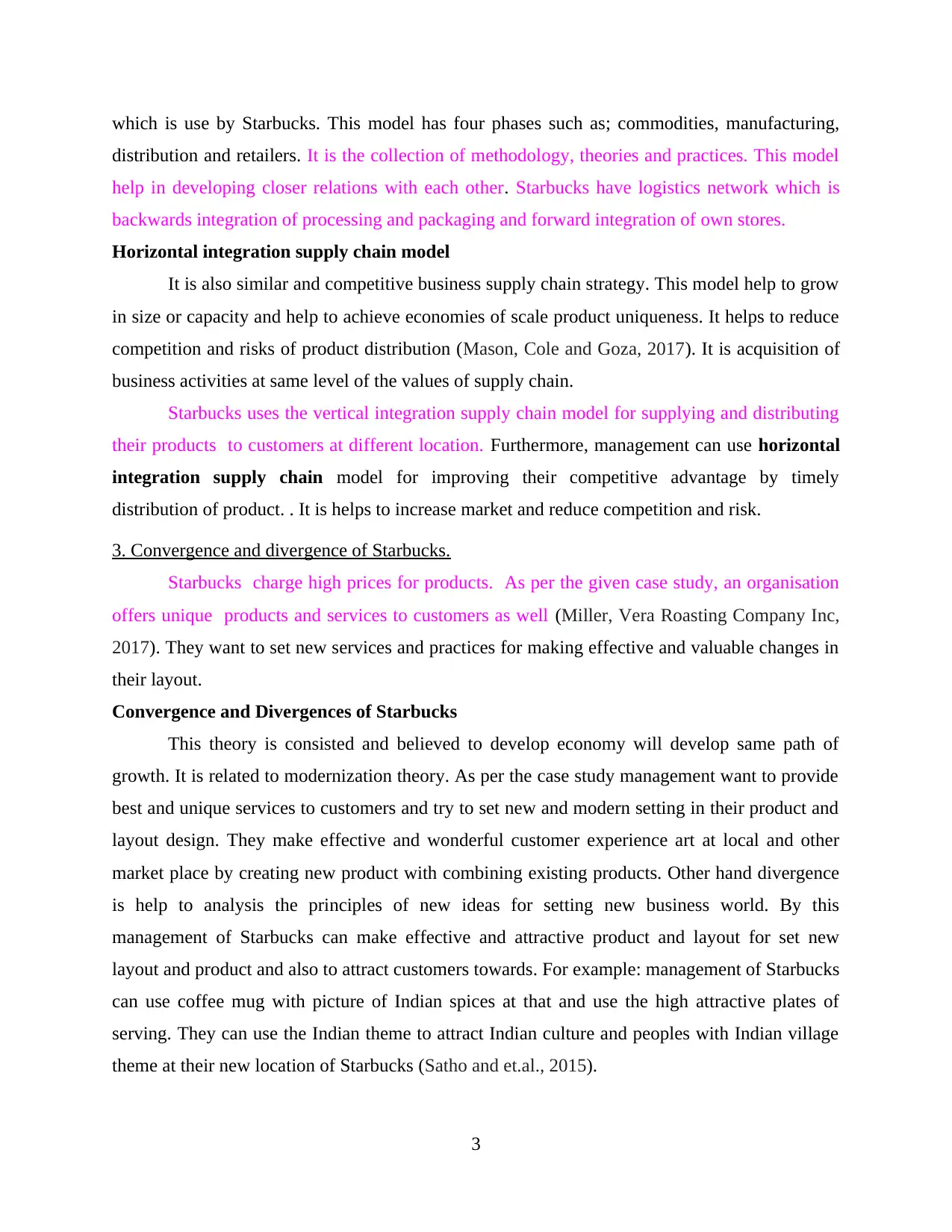
which is use by Starbucks. This model has four phases such as; commodities, manufacturing,
distribution and retailers. It is the collection of methodology, theories and practices. This model
help in developing closer relations with each other. Starbucks have logistics network which is
backwards integration of processing and packaging and forward integration of own stores.
Horizontal integration supply chain model
It is also similar and competitive business supply chain strategy. This model help to grow
in size or capacity and help to achieve economies of scale product uniqueness. It helps to reduce
competition and risks of product distribution (Mason, Cole and Goza, 2017). It is acquisition of
business activities at same level of the values of supply chain.
Starbucks uses the vertical integration supply chain model for supplying and distributing
their products to customers at different location. Furthermore, management can use horizontal
integration supply chain model for improving their competitive advantage by timely
distribution of product. . It is helps to increase market and reduce competition and risk.
3. Convergence and divergence of Starbucks.
Starbucks charge high prices for products. As per the given case study, an organisation
offers unique products and services to customers as well (Miller, Vera Roasting Company Inc,
2017). They want to set new services and practices for making effective and valuable changes in
their layout.
Convergence and Divergences of Starbucks
This theory is consisted and believed to develop economy will develop same path of
growth. It is related to modernization theory. As per the case study management want to provide
best and unique services to customers and try to set new and modern setting in their product and
layout design. They make effective and wonderful customer experience art at local and other
market place by creating new product with combining existing products. Other hand divergence
is help to analysis the principles of new ideas for setting new business world. By this
management of Starbucks can make effective and attractive product and layout for set new
layout and product and also to attract customers towards. For example: management of Starbucks
can use coffee mug with picture of Indian spices at that and use the high attractive plates of
serving. They can use the Indian theme to attract Indian culture and peoples with Indian village
theme at their new location of Starbucks (Satho and et.al., 2015).
3
distribution and retailers. It is the collection of methodology, theories and practices. This model
help in developing closer relations with each other. Starbucks have logistics network which is
backwards integration of processing and packaging and forward integration of own stores.
Horizontal integration supply chain model
It is also similar and competitive business supply chain strategy. This model help to grow
in size or capacity and help to achieve economies of scale product uniqueness. It helps to reduce
competition and risks of product distribution (Mason, Cole and Goza, 2017). It is acquisition of
business activities at same level of the values of supply chain.
Starbucks uses the vertical integration supply chain model for supplying and distributing
their products to customers at different location. Furthermore, management can use horizontal
integration supply chain model for improving their competitive advantage by timely
distribution of product. . It is helps to increase market and reduce competition and risk.
3. Convergence and divergence of Starbucks.
Starbucks charge high prices for products. As per the given case study, an organisation
offers unique products and services to customers as well (Miller, Vera Roasting Company Inc,
2017). They want to set new services and practices for making effective and valuable changes in
their layout.
Convergence and Divergences of Starbucks
This theory is consisted and believed to develop economy will develop same path of
growth. It is related to modernization theory. As per the case study management want to provide
best and unique services to customers and try to set new and modern setting in their product and
layout design. They make effective and wonderful customer experience art at local and other
market place by creating new product with combining existing products. Other hand divergence
is help to analysis the principles of new ideas for setting new business world. By this
management of Starbucks can make effective and attractive product and layout for set new
layout and product and also to attract customers towards. For example: management of Starbucks
can use coffee mug with picture of Indian spices at that and use the high attractive plates of
serving. They can use the Indian theme to attract Indian culture and peoples with Indian village
theme at their new location of Starbucks (Satho and et.al., 2015).
3
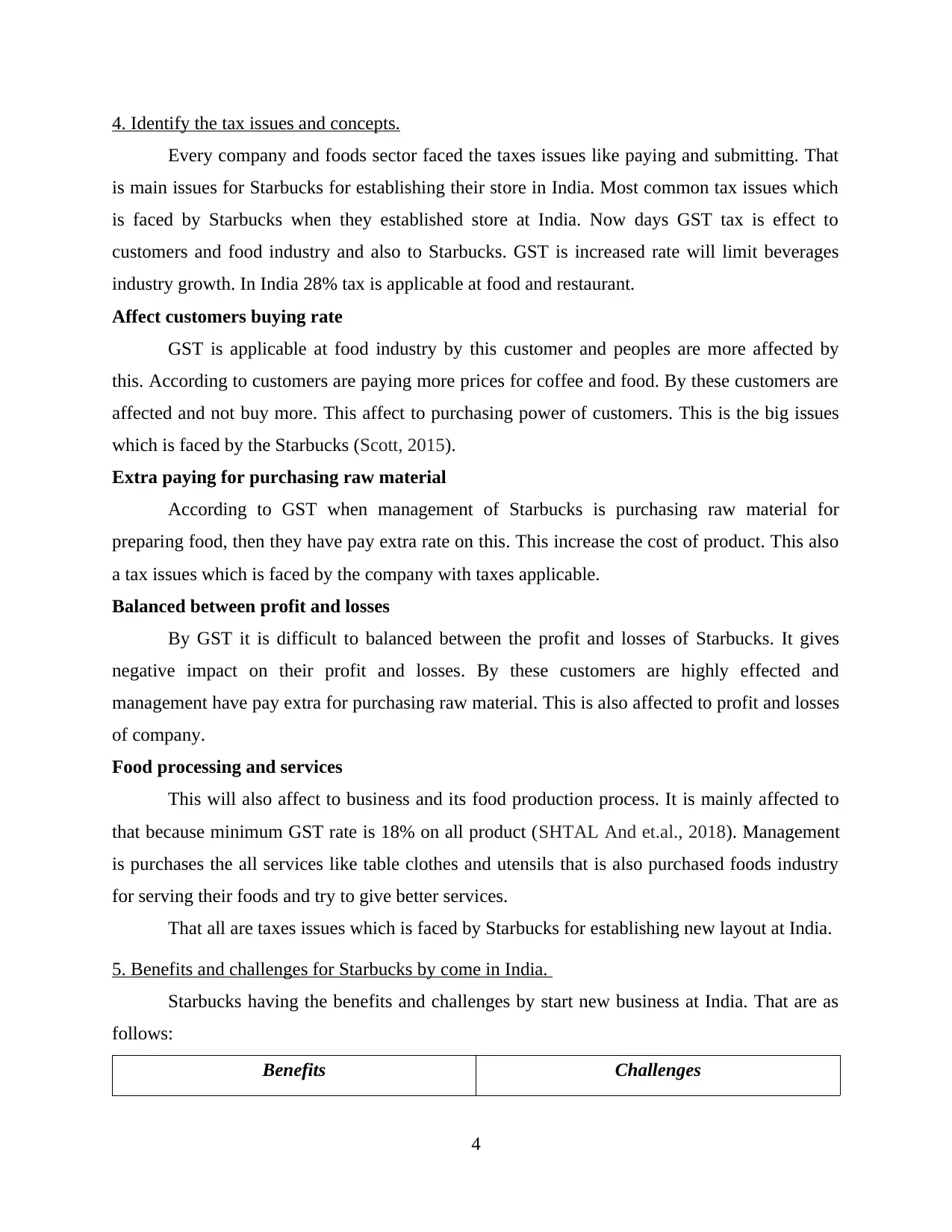
4. Identify the tax issues and concepts.
Every company and foods sector faced the taxes issues like paying and submitting. That
is main issues for Starbucks for establishing their store in India. Most common tax issues which
is faced by Starbucks when they established store at India. Now days GST tax is effect to
customers and food industry and also to Starbucks. GST is increased rate will limit beverages
industry growth. In India 28% tax is applicable at food and restaurant.
Affect customers buying rate
GST is applicable at food industry by this customer and peoples are more affected by
this. According to customers are paying more prices for coffee and food. By these customers are
affected and not buy more. This affect to purchasing power of customers. This is the big issues
which is faced by the Starbucks (Scott, 2015).
Extra paying for purchasing raw material
According to GST when management of Starbucks is purchasing raw material for
preparing food, then they have pay extra rate on this. This increase the cost of product. This also
a tax issues which is faced by the company with taxes applicable.
Balanced between profit and losses
By GST it is difficult to balanced between the profit and losses of Starbucks. It gives
negative impact on their profit and losses. By these customers are highly effected and
management have pay extra for purchasing raw material. This is also affected to profit and losses
of company.
Food processing and services
This will also affect to business and its food production process. It is mainly affected to
that because minimum GST rate is 18% on all product (SHTAL And et.al., 2018). Management
is purchases the all services like table clothes and utensils that is also purchased foods industry
for serving their foods and try to give better services.
That all are taxes issues which is faced by Starbucks for establishing new layout at India.
5. Benefits and challenges for Starbucks by come in India.
Starbucks having the benefits and challenges by start new business at India. That are as
follows:
Benefits Challenges
4
Every company and foods sector faced the taxes issues like paying and submitting. That
is main issues for Starbucks for establishing their store in India. Most common tax issues which
is faced by Starbucks when they established store at India. Now days GST tax is effect to
customers and food industry and also to Starbucks. GST is increased rate will limit beverages
industry growth. In India 28% tax is applicable at food and restaurant.
Affect customers buying rate
GST is applicable at food industry by this customer and peoples are more affected by
this. According to customers are paying more prices for coffee and food. By these customers are
affected and not buy more. This affect to purchasing power of customers. This is the big issues
which is faced by the Starbucks (Scott, 2015).
Extra paying for purchasing raw material
According to GST when management of Starbucks is purchasing raw material for
preparing food, then they have pay extra rate on this. This increase the cost of product. This also
a tax issues which is faced by the company with taxes applicable.
Balanced between profit and losses
By GST it is difficult to balanced between the profit and losses of Starbucks. It gives
negative impact on their profit and losses. By these customers are highly effected and
management have pay extra for purchasing raw material. This is also affected to profit and losses
of company.
Food processing and services
This will also affect to business and its food production process. It is mainly affected to
that because minimum GST rate is 18% on all product (SHTAL And et.al., 2018). Management
is purchases the all services like table clothes and utensils that is also purchased foods industry
for serving their foods and try to give better services.
That all are taxes issues which is faced by Starbucks for establishing new layout at India.
5. Benefits and challenges for Starbucks by come in India.
Starbucks having the benefits and challenges by start new business at India. That are as
follows:
Benefits Challenges
4
⊘ This is a preview!⊘
Do you want full access?
Subscribe today to unlock all pages.

Trusted by 1+ million students worldwide
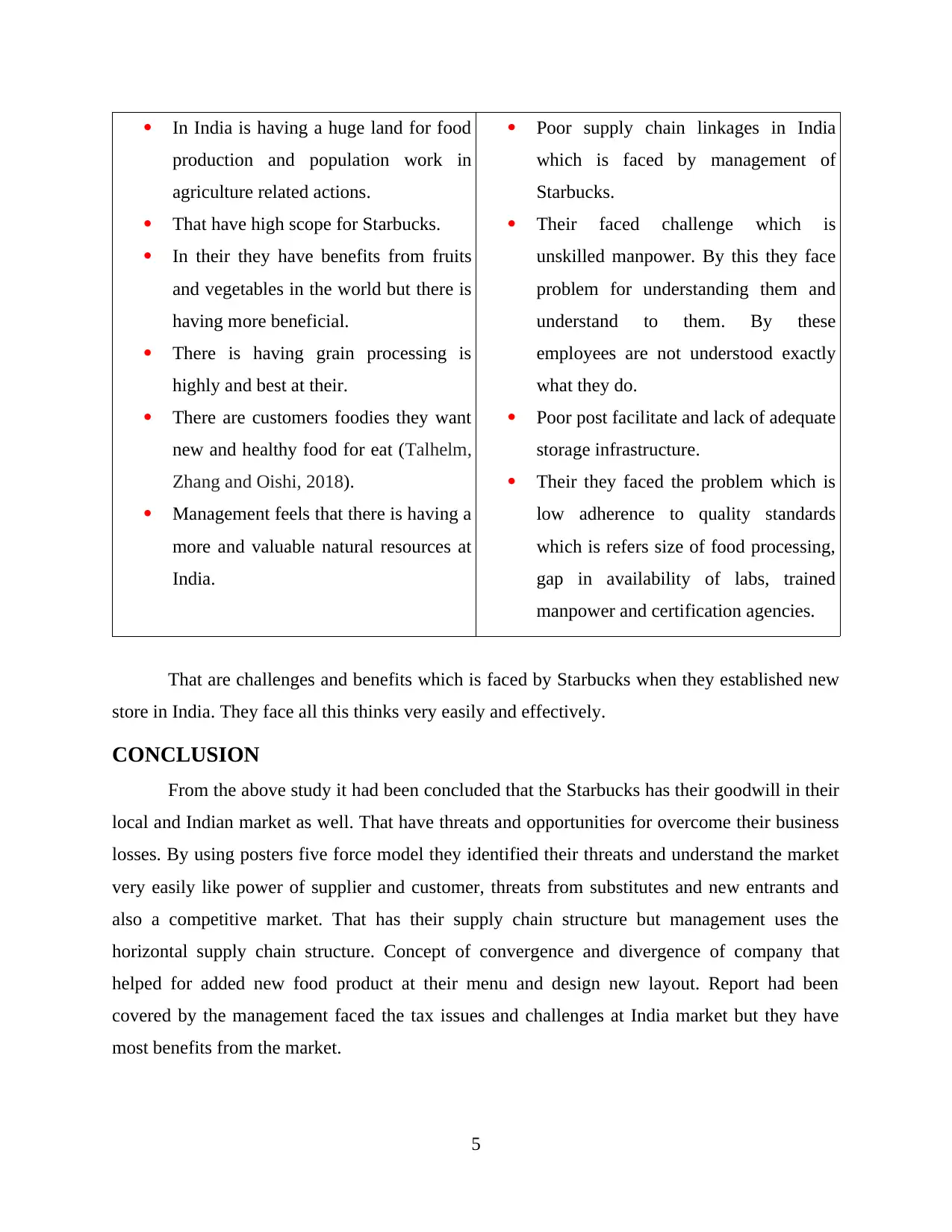
In India is having a huge land for food
production and population work in
agriculture related actions.
That have high scope for Starbucks.
In their they have benefits from fruits
and vegetables in the world but there is
having more beneficial.
There is having grain processing is
highly and best at their.
There are customers foodies they want
new and healthy food for eat (Talhelm,
Zhang and Oishi, 2018).
Management feels that there is having a
more and valuable natural resources at
India.
Poor supply chain linkages in India
which is faced by management of
Starbucks.
Their faced challenge which is
unskilled manpower. By this they face
problem for understanding them and
understand to them. By these
employees are not understood exactly
what they do.
Poor post facilitate and lack of adequate
storage infrastructure.
Their they faced the problem which is
low adherence to quality standards
which is refers size of food processing,
gap in availability of labs, trained
manpower and certification agencies.
That are challenges and benefits which is faced by Starbucks when they established new
store in India. They face all this thinks very easily and effectively.
CONCLUSION
From the above study it had been concluded that the Starbucks has their goodwill in their
local and Indian market as well. That have threats and opportunities for overcome their business
losses. By using posters five force model they identified their threats and understand the market
very easily like power of supplier and customer, threats from substitutes and new entrants and
also a competitive market. That has their supply chain structure but management uses the
horizontal supply chain structure. Concept of convergence and divergence of company that
helped for added new food product at their menu and design new layout. Report had been
covered by the management faced the tax issues and challenges at India market but they have
most benefits from the market.
5
production and population work in
agriculture related actions.
That have high scope for Starbucks.
In their they have benefits from fruits
and vegetables in the world but there is
having more beneficial.
There is having grain processing is
highly and best at their.
There are customers foodies they want
new and healthy food for eat (Talhelm,
Zhang and Oishi, 2018).
Management feels that there is having a
more and valuable natural resources at
India.
Poor supply chain linkages in India
which is faced by management of
Starbucks.
Their faced challenge which is
unskilled manpower. By this they face
problem for understanding them and
understand to them. By these
employees are not understood exactly
what they do.
Poor post facilitate and lack of adequate
storage infrastructure.
Their they faced the problem which is
low adherence to quality standards
which is refers size of food processing,
gap in availability of labs, trained
manpower and certification agencies.
That are challenges and benefits which is faced by Starbucks when they established new
store in India. They face all this thinks very easily and effectively.
CONCLUSION
From the above study it had been concluded that the Starbucks has their goodwill in their
local and Indian market as well. That have threats and opportunities for overcome their business
losses. By using posters five force model they identified their threats and understand the market
very easily like power of supplier and customer, threats from substitutes and new entrants and
also a competitive market. That has their supply chain structure but management uses the
horizontal supply chain structure. Concept of convergence and divergence of company that
helped for added new food product at their menu and design new layout. Report had been
covered by the management faced the tax issues and challenges at India market but they have
most benefits from the market.
5
Paraphrase This Document
Need a fresh take? Get an instant paraphrase of this document with our AI Paraphraser
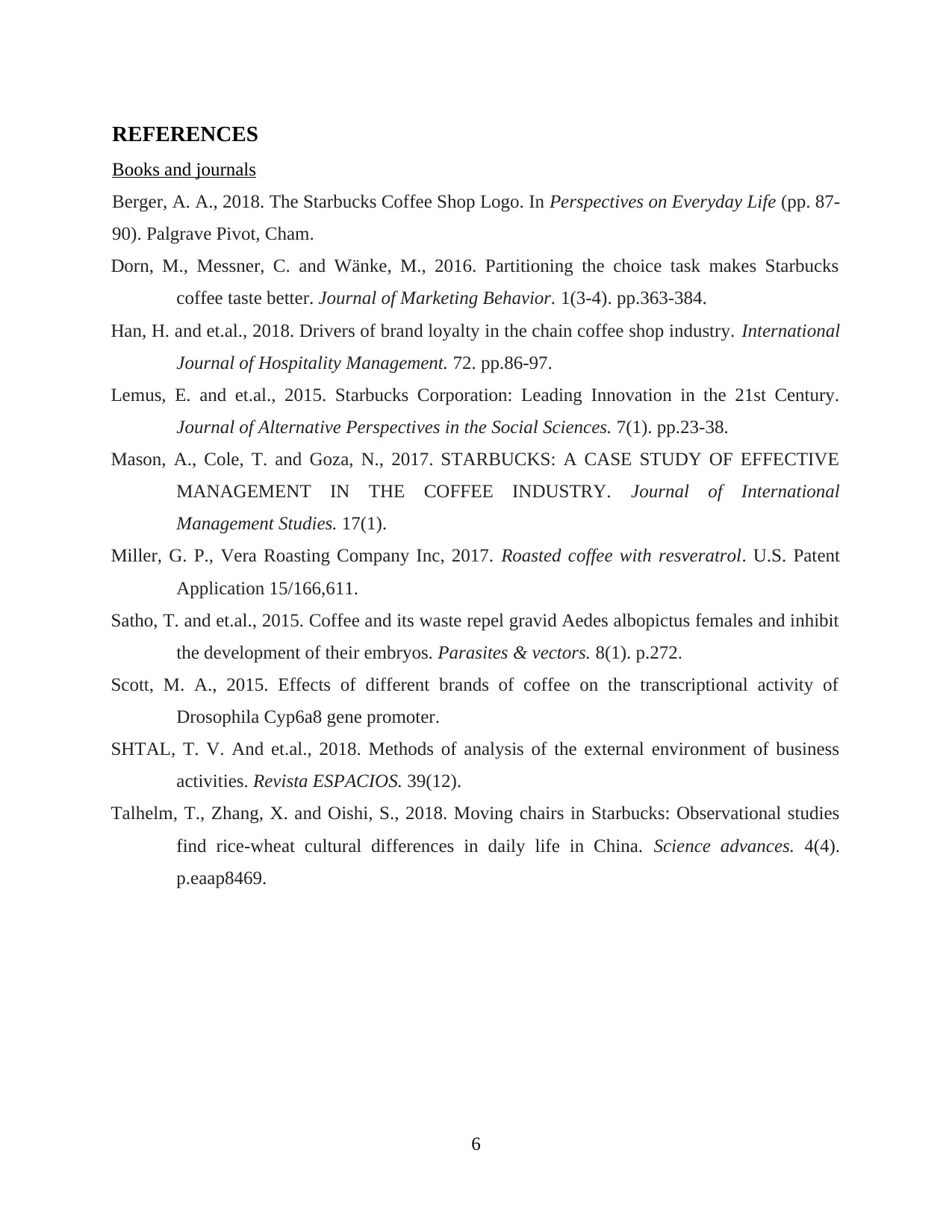
REFERENCES
Books and journals
Berger, A. A., 2018. The Starbucks Coffee Shop Logo. In Perspectives on Everyday Life (pp. 87-
90). Palgrave Pivot, Cham.
Dorn, M., Messner, C. and Wänke, M., 2016. Partitioning the choice task makes Starbucks
coffee taste better. Journal of Marketing Behavior. 1(3-4). pp.363-384.
Han, H. and et.al., 2018. Drivers of brand loyalty in the chain coffee shop industry. International
Journal of Hospitality Management. 72. pp.86-97.
Lemus, E. and et.al., 2015. Starbucks Corporation: Leading Innovation in the 21st Century.
Journal of Alternative Perspectives in the Social Sciences. 7(1). pp.23-38.
Mason, A., Cole, T. and Goza, N., 2017. STARBUCKS: A CASE STUDY OF EFFECTIVE
MANAGEMENT IN THE COFFEE INDUSTRY. Journal of International
Management Studies. 17(1).
Miller, G. P., Vera Roasting Company Inc, 2017. Roasted coffee with resveratrol. U.S. Patent
Application 15/166,611.
Satho, T. and et.al., 2015. Coffee and its waste repel gravid Aedes albopictus females and inhibit
the development of their embryos. Parasites & vectors. 8(1). p.272.
Scott, M. A., 2015. Effects of different brands of coffee on the transcriptional activity of
Drosophila Cyp6a8 gene promoter.
SHTAL, T. V. And et.al., 2018. Methods of analysis of the external environment of business
activities. Revista ESPACIOS. 39(12).
Talhelm, T., Zhang, X. and Oishi, S., 2018. Moving chairs in Starbucks: Observational studies
find rice-wheat cultural differences in daily life in China. Science advances. 4(4).
p.eaap8469.
6
Books and journals
Berger, A. A., 2018. The Starbucks Coffee Shop Logo. In Perspectives on Everyday Life (pp. 87-
90). Palgrave Pivot, Cham.
Dorn, M., Messner, C. and Wänke, M., 2016. Partitioning the choice task makes Starbucks
coffee taste better. Journal of Marketing Behavior. 1(3-4). pp.363-384.
Han, H. and et.al., 2018. Drivers of brand loyalty in the chain coffee shop industry. International
Journal of Hospitality Management. 72. pp.86-97.
Lemus, E. and et.al., 2015. Starbucks Corporation: Leading Innovation in the 21st Century.
Journal of Alternative Perspectives in the Social Sciences. 7(1). pp.23-38.
Mason, A., Cole, T. and Goza, N., 2017. STARBUCKS: A CASE STUDY OF EFFECTIVE
MANAGEMENT IN THE COFFEE INDUSTRY. Journal of International
Management Studies. 17(1).
Miller, G. P., Vera Roasting Company Inc, 2017. Roasted coffee with resveratrol. U.S. Patent
Application 15/166,611.
Satho, T. and et.al., 2015. Coffee and its waste repel gravid Aedes albopictus females and inhibit
the development of their embryos. Parasites & vectors. 8(1). p.272.
Scott, M. A., 2015. Effects of different brands of coffee on the transcriptional activity of
Drosophila Cyp6a8 gene promoter.
SHTAL, T. V. And et.al., 2018. Methods of analysis of the external environment of business
activities. Revista ESPACIOS. 39(12).
Talhelm, T., Zhang, X. and Oishi, S., 2018. Moving chairs in Starbucks: Observational studies
find rice-wheat cultural differences in daily life in China. Science advances. 4(4).
p.eaap8469.
6
1 out of 8
Related Documents
Your All-in-One AI-Powered Toolkit for Academic Success.
+13062052269
info@desklib.com
Available 24*7 on WhatsApp / Email
![[object Object]](/_next/static/media/star-bottom.7253800d.svg)
Unlock your academic potential
Copyright © 2020–2025 A2Z Services. All Rights Reserved. Developed and managed by ZUCOL.




